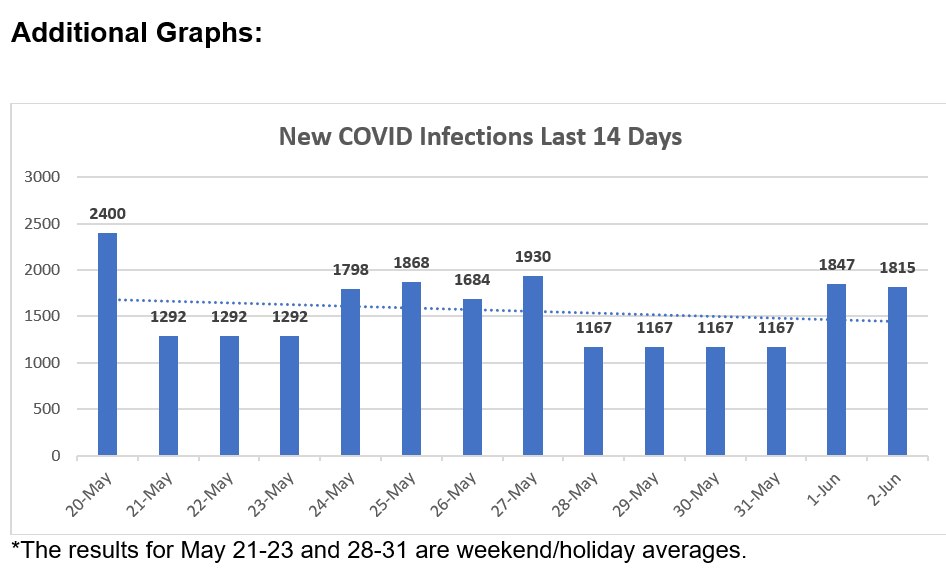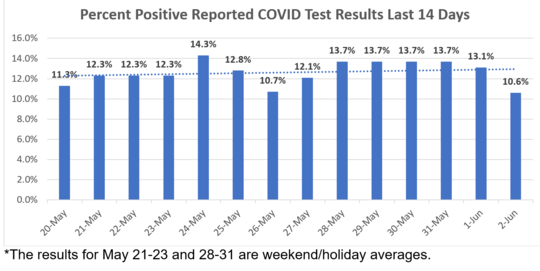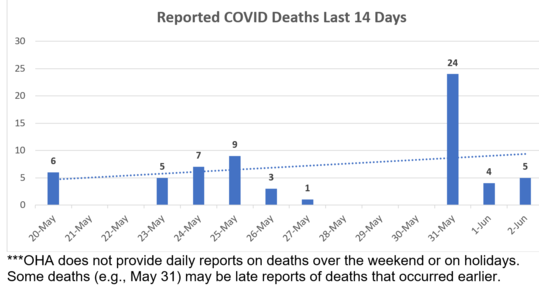|
June 3, 2022
Dear Neighbors and Friends,
I hope that you and your loved ones are doing well, staying healthy, and looking out for your neighbors and friends during this past week.
On the legislative front, it’s been a full week of committee and task force hearings during our quarterly “Legislative Days.” It was an opportunity for us to catch up on what’s happening all across state government, legislative action, and budget needs. You can find links to all hearings, recordings, and meeting materials in last week's newsletter.. I’ll share some highlights next week.
Tomorrow is another SD 23 Constituent Coffee. You’ll find more on that below.
On the COVID front, we’re starting to experience a slowdown in new COVID infections and hospitalizations. The latest OHSU forecast, which came out moments ago, suggests that the current surge is now cresting in Oregon. This may be counterintuitive to many of us as we see more of our friends, coworkers, loved ones, and acquaintances testing positive, but it appears to be the case on a macro level. And most (though not all) of these infections are relatively mild, thanks to the effects of Oregon’s high levels of COVID vaccinations and the availability of Paxlovid and other treatments.
You’ll find details on all of these developments in this newsletter, along with the links and graphs that will clarify the current status of the pandemic for you. You’ll also find the latest COVID forecast from OHSU, which shows us to be largely on track with earlier forecasts.
Until the next newsletter, please stay healthy and safe. And let me know if you have any questions or thoughts about anything in tonight’s newsletter.
COMING ON SATURDAY: June Zoom Constituent Coffee!!!
Tomorrow, June 4, is the first Saturday of the month, which means another monthly constituent coffee from 9 am to 10:30 am. We’ll be returning to Zoom for this meeting. (I’m alternating between in-person and remote for now.)
It will be a chance for me to report on highlights of the upcoming committee hearings, on various work groups, let you know about bills likely to come our way in 2023, get your thoughts on priorities and future action.
You can register for the June 4 coffee here. Hope to see you there!
Signing Up for Gun Violence Prevention
Today is National Gun Violence Awareness Day. Let me take the opportunity to remind you of the signature-gathering that is occurring to get an important initiative onto the ballot. It’s Initiative Petition 17--The Reduction of Gun Violence Act, an effort organized by a coalition of faith leaders. It would do two important things: limit the ammunition capacity of firearms magazines and require a permit to purchase a firearm. Both of these strategies have been shown to be very effective in limiting gun violence.
Here's info about the initiative and the effort behind it, lifteveryvoiceoregon.com
Thanks to changes recently made by the Legislature, you can now download, print out, sign, and mail in a petition directly from your home. Here's how.
Getting this passed would send a clear message to the Legislature that Oregonians want real change right away and would also send a strong signal to the nation as a whole. However, this is not a well-funded campaign, and getting a measure onto the ballot is not easy. Please do what you can to help, starting with your own signature.
ON THE COVID FRONT
Biweekly and Weekly Reports:
Biweekly: OHA’s COVID-19 Biweekly Data Report was published on Thursday due to the Memorial Day holiday. It shows an increase COVID-19-related cases, hospitalizations and deaths since the previous biweekly period. The biweekly Outbreak Report was also released yesterday.
OHA reported 22,845 new cases of COVID-19 from May 16 to May 29, a 24% increase over the previous biweekly total of 18,447. There were 549 new COVID-19-related hospitalizations during the biweekly period, more than double from the 208 reported during the previous two-week period. (However, as you’ll see just below, week #2 of this 2-week period is showing slowdowns in these rates.)
The biweekly Outbreak Report shows 14 COVID deaths in congregate care settings over the last two weeks.
Weekly: And here is week-over-week information that I’ve compiled from the daily reports for the past week. At the end of the newsletter you’ll also find graphs that I’ve put together showing the daily counts and trends for the last two weeks.
Overall, we’re seeing a stabilization or slowdown in the rates of increase.
- The big week-over-week increases in positive test results that we were seeing are continuing to slow down. OHA reported 10,260 new cases of COVID-19 during the week of May 27-June 2 (vs. 11,536 the week before), a 7-day average of 1,466 per day (vs 1,648 the previous week). The number of new cases is again likely an undercount, as many people are using home tests to determine their infection status but are not reporting those results.
- On Thursday there were 307 COVID-19-related hospitalizations, unchanged from last Thursday. This slowdown suggests that we may not hit the peak of 329 projected in the latest OHSU forecast ahead of the June 9th date forecast in earlier OHSU forecast reports. Again, many of these hospitalizations are not in and of themselves due to COVID—they include those who tested positive after having been admitted for other reasons.
- The number of COVID patients in Oregon’s ICUs is now 30, again unchanged from last week. These are of course the individuals with the most serious cases.
- There were 34 reported COVID-19-related deaths during the last week, vs. 30 last week. However, 24 of those came in one day and were likely reporting catch-ups of deaths that occurred during earlier weeks.
- Reported COVID-19 test results again decreased from last week. There were 92,940 reported, vs. 97,071 last week. Again, this probably doesn’t count the majority of tests happening at home.
- Average test positivity for the last week was 12.9%, a small increase from the previous week’s 12.3% (ending several weeks of large increases). Again, this number skews high because it likely reflects a higher proportion of people showing COVID symptoms (and thus going in for a test, rather than self-testing).
Weekly County Report: Half of Oregon’s Counties Now at Medium Risk; Percent Positives Continue to Rise
OHA is no longer providing a weekly county report each Monday, but there are still ways to track this data. According to the CDC Daily Counter (updated each Thursday), 18 Oregon counties have reported infection rates that place them in the Medium Risk category: Benton, Clackamas, Columbia, Coos, Crook, Curry, Deschutes, Grant, Hood River, Lane, Marion, Multnomah, Polk, Tillamook, Union, Wallowa, Wasco, and Washington (up from 12). The remaining 18 Oregon counties remain at Low Risk.
Again, we must remember that these are only the tests results that have been reported. With the prevalence of home tests, there are certainly many more positive cases out there that have not been reported.
Here’s what the CDC recommends for this category: Stay up to date with COVID-19 vaccines. Get tested if you have symptoms. Wear a mask if you have symptoms, a positive test, or exposure to someone with COVID-19. Wear a mask on public transportation. You may choose to wear a mask at any time as an additional precaution to protect yourself and others. If you are at high risk for severe illness, consider wearing a mask indoors in public and taking additional precautions.
We can also track the test positivity rates for each county and the state as a whole at this dashboard. The test positivity rates reported this week show continued increases.
Among the reported cases, the statewide infection rate has risen from 13.9% last week to 15.0% this week.
At 16.6%, Multnomah County is again above the state average, increasing from last week’s 14.6%. It is right at the Portland Tri-County average, which is now 16.5% (up from last week’s 14.5%).

This Week’s Wastewater Monitoring Report Shows Increase in Number of Cities with Steady COVID Increases
With testing reports giving us just a fraction of infections out there, wastewater monitoring has become a more reliable indicator of the amount of virus in cities around the state. That report is updated each week.
This week’s report shows us that the following 13 cities (up from 5 last week) are showing sustained increases: Ashland, Canby, Eugene, Florence, Grants Pass, Hermiston, Medford, Newberg, Newport, Portland, Redmond, Salem, and St. Helens.
OHSU Forecast: The Current Surge Has Crested and We Can Expect Gradual Declines
The current OHSU COVID report and forecast, published this evening, uses data provided by OHA and others that project how fast the virus may spread in the population and provides projections on possible outcomes, including infection rates and impacts on hospital capacity. The lead author is Dr. Peter Graven, Director of OHSU’s Office of Advanced Analytics. It appears every two weeks.
This forecast remains essentially the same as previous forecasts going back to April 8.
The current forecast reflects a belief that cases have now crested and we shouldn’t be seeing sizeable increases in hospitalizations. It is worth noting again that many if not most of those are not being admitted for COVID but have tested positive upon admission. The number of those in intensive care for COVID is not increasing.
We can expect gradual declines in cases and hospitalizations, as states in the Northeast (which began their surge ahead of us) are now experiencing.
Here are key observations in this week’s report:
- Oregon cases levels are about middle of the pack (19th in US) and appear to have crested (though still high).
- The model is showing a longer period of plateau before the decline which is different than previous peaks which were sharper in nature.
- Oregon hospital census as of 6/2 is 307. This is an increase of 26 beds since the 281 presented last report on May 20.
- The peak in hospitalizations is now shown to be 313 on 6/14/2022, down slightly from the previous forecasted peak of 329.
- Symptom levels, as measured by surveys, are consistent with infection levels close to as high as BA1 wave during January.
- Deaths are at their lowest levels of the pandemic.
- BA5 is reported at 90% of sequenced strains in Portugal and associated with an increase in cases and hospitalizations. The incidental rate of hospitalization is not reported and may be high.
- As of Jun 1, 5% of occupied ICU beds have COVID patients in them statewide. This is unchanged from two weeks ago.
- Pediatric hospitalizations increased modestly to 12.
- Wastewater surveillance levels show elevated levels of disease consistent with case counts and symptom levels.
- States in the Northeast have already begun seeing decreases in hospital census.
- Masking in much of Oregon remains unchanged from April; large indoor events are lower than in most other parts of the nation.
Additional COVID Updates and Links
From OHA: COVID Q&As
Dr. Andrea Lara, MD, MPH, Oregon Health Authority (OHA) health advisor, answered the following questions.
Q: I just tested positive on a home test kit. I am 70 years old. How can I get the medication I need? Cynthia, Banks
A: You can get treatments by contacting your health care provider as soon as you develop symptoms. Antivirals, such as Paxlovid, need to be started within five days of the start of your symptoms. If you do not have a health care provider, call 211 to be connected with resources. You can also use the federal Test to Treat locator to find a Test to Treat site near you. Please note, some areas of Oregon do not yet have any Test to Treat sites. However, if you have a health care provider who can send a prescription to a pharmacy, you can use the Test to Treat website to find a nearby pharmacy that can fill that prescription. You can find more details on Test to Treat here.
Q: I would like to know if most people over 65 with COVID are choosing to take the antiviral medication and if it helps to keep them out of the hospital. – Virginia, Beaverton
A: “Hi Virginia. We don’t have a way to track how many people age 65 and older are taking antiviral medications for COVID-19. We have seen overall use increasing during the past month, and there is good evidence that these medicines greatly decrease the risk of hospitalization and death among those at risk for severe illness due to age or underlying health conditions.”
Q: I got COVID, took the Paxlovid five-day regimen and afterward, though I feel much better (like normal), I still test positive. I was told by an Urgent Care person that I could test positive for three months. Is that true? – Rene, Springfield
A: “It’s possible to continue to test positive for a period of time following a COVID-19 infection. While this doesn’t happen with everyone, some people continue to have a positive COVID-19 test for weeks to even months after their illness. This happens more often with PCR tests, which are better at detecting small pieces of viral material. If you have new symptoms consistent with COVID-19 infection and you test positive within 90 days of your last infection, you have most likely been reinfected with COVID-19."
Q: My wife and I tested positive for COVID-19 on Monday and are currently both on Paxlovid and recovering. We had appointments to get our second boosters this weekend but have canceled them since we are sick. How soon after recovering with the help of Paxlovid should we get our second boosters? – Tom, Tigard
A: “You can get your second booster once your symptoms of acute COVID-19 illness have resolved, and you’ve completed your isolation so you can no longer infect others. Having taken Paxlovid doesn’t require any additional delay. You may consider waiting 90 days after being infected to get your booster because there is evidence that a COVID-19 infection provides significant immunity that weakens after few months."
Q: I have COPD. If I catch COVID, my outcome may be poor. Does Oregon have sufficient treatments on hand (the antiviral pill, etc.) to treat high-risk patients? I’m vaccinated and I mask, but it still concerns me. – Sharon, Salem
A: “Oregon receives a weekly, fluctuating supply of COVID-19 treatments from the federal government. At this time, the federal government says there is no longer a shortage of these antivirals, and they are available at hundreds of pharmacies across Oregon with a doctor’s prescription. You can locate one of those pharmacies near you by visiting the federal Test to Treat (T2T) webpage. If you have a health care provider who can assess your condition and prescribe the antiviral medication, enter your ZIP code into the T2T locator and the click on ‘Locations to fill a prescription.’ If you don’t have a health care provider or can’t see them same day or next day from the start of your symptoms, Test to Treat sites are a good option. At this time there are no T2T sites in Salem, but there are a few in the Portland Metro area. You can also find those by entering your ZIP code into the T2T locator, but then clicking on ‘Locations with testing, medical visits and medication.’ You can find more details on T2T here.”





Here again are some COVID resources that you will find useful:
If the above links are not providing you with answers to your questions or directing you to the help that you need, please consider me and my office to be a resource. We’ll do our best to assist you or steer you in the right direction.
Want to See Past Newsletters?
If there was COVID-related information in a past newsletter that you want to go back to, but find you’ve deleted it, you can always go to my legislative website (senatordembrow.com), click on “News and Information,” and you’ll find them all there. Also, if someone forwarded you this newsletter and you’d like to get it directly, you can sign up for it there.
Best,
 Senator Michael Dembrow
District 23
email: Sen.MichaelDembrow@oregonlegislature.gov
web: www.senatordembrow.com
phone: 503-281-0608
mail: 900 Court St NE, S-407, Salem, OR, 97301
|